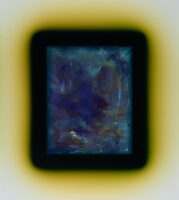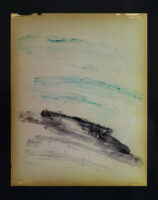
Q&A with Justine Varga
5.5.20
Though seemingly abstract, Justine Varga’s luminous work brings a complete new notion of realism which is sometimes made with a camera or without. Exposing, weathering and handling film in a way that absorbs nuances of her daily life, Justine presents film that breathes and bears witness.
Justine’s new exhibition, Tachisme, which was scheduled for our original festival dates is now available to view online at Tolarno Galleries' virtual viewing space until 9 May. We are looking forward to seeing the full exhibition as a site specific installation at Tolarno Galleries for PHOTO 2021.
Our Q&A with Justine delves into her practice, current state of mind and intent for being an artist in today’s climate.
What started your relationship with photography?
The darkroom when I was in year eight at high school.
What is your motivation for making art? How has your practice changed over time?
As an artist working with the medium of photography today, I begin by asking myself what kind of photograph do I want to contribute? Along with film, I use a fairly limited amount of prosaic and abject materials in the production of my photographs, coupled with various darkroom processes. With these tools, I’m continually pushing at the edges of what undoubtedly is the most ubiquitous medium of our time.
I find that the further I go in a certain direction, the greater the expanse of possibilities that opens before me. I believe this is due to my conceptual approach to photography, seeing it not only as a set of processes and materials, but also as an idea with very particular social and political functions. These functions are what I’m constantly circling around with my work, looking at them from different vantage points. So, whether that means realising the photographic act in terms of performance, drawing, painting, or a set of exchanges and bodily inscriptions, at the core of my endeavour is an effort to unpack the very identity of the photograph and what it means within a contemporary context.
How do ideas relating to 'The Truth’ factor into your practice?
While seemingly abstract, my photographs are entirely realist. By rejecting all illusions, they restore fidelity to the medium.

Contusion, 2018-19
In this post-internet age, how do you see the viewer in relation to your artwork?
Many of my photographs derive from long exposures and are physically ‘worked’ in multiple ways to arrive at the final print. The reception of my photographs by other viewers is something that therefore occurs at the end of my own prolonged process of thinking, and making, and considering. First and foremost, I always create the work that I feel is necessary for me. If it passes that test, then I trust my audience will respond similarly. Pre or post-internet, I do not believe this imperative has changed for artists. I welcome as many eyes as possible to gaze upon my photography, so the more venues and platforms this can occur on and within, the better.
How do you go about developing new projects?
My practice is accumulative. Each work informs the next, and each new series contains all that I know about the medium at that moment in time.

Aggregate, 2018-19
How does your lived experience influence your work?
Everything I come into contact with has an effect on me and therefore on my photography.
What books are you currently reading?
Where the Light Falls by Gretchin Shirm, a delicately rendered novel about photographic portraiture (and by an Australian author); I’m also on a Georges Didi-Huberman binge, at the same time as I’m reading the catalogue Beauty, Sex and Power: A Story of Debauchery and Decadent Art at the Late Stuart Court 1610-1714 (British Baroque at Tate Britain was one of the last exhibitions I saw before lockdown). The overarching link between these texts is the nature of representation. Who makes these representations, how do they do it and why?
What is your favourite website or social media account?
Reputable news outlets.
What music are you listening to?
Joy Division, “From Safety to Where…?”
How are you spending your time with the current social distancing restrictions?
It has been a time to reflect on the past and imagine possible futures. I am looking forward to letting these thoughts manifest themselves and feeling them under hand.
![Image: Justine Varga, [Influence], 2018-19.](https://photo.org.au/api/wp-content/uploads/2020/04/Justine-Varga_Influence_2018-19_new-168x200.jpg)
Influence, 2018-19
How do you hope our creative community will overcome this unique challenge?
I believe creative people have a unique ability to thrive in adversity. For artists, overcoming difficulty is not unique: this is the challenge on a day-to-day basis. Not to say the current situation is business as usual (I have not yet lived through a pandemic), but many artists have chosen alternative pathways before today.
We have already asked ourselves, how does one survive against the grain? How does one face one’s self and one’s own limitations? How do we create opportunity for ourselves and others? How do we make things and make do with what we have? How do we engage critically with the world through our work?
We are experienced in answering these questions and implementing those answers. This is why people look to artists to see their world distilled and reflected. This is why it is our responsibility to find possible answers to questions otherwise left unarticulated. This is why our sector is drawn heavily upon to rejuvenate localities and industries so they can thrive. Through creativity, we are able to overcome blindness and reveal what is plainly before us. We are the change agenda.

Refraction, 2018-19